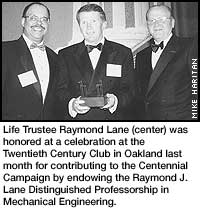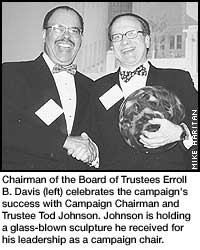|
|
||
|
|
|
(The following story was published in the June 13, 2001 Carnegie Mellon News.) Centennial Campaign Raises Record $410.3 Million "Success of Campaign Benefits Entire University Community," Says Board Chairman
The final amount was more than $60 million above the campaign goal of $350 million and almost $200 million more than the $229.4 million raised in the Campaign for Carnegie Mellon from 1985-91.
"Great news, but what's in it for me?" you might ask. Carnegie Mellon's Chairman of the Board of Trustees Erroll B. Davis Jr. (E 1965) says there's something for everyone.
"The success of the campaign benefits the entire university community," said Davis, president and chief executive officer of Alliant Energy in Madison, Wis. "Whether you're a student, member of the faculty, staff member, graduate, member of the board or friend of Carnegie Mellon, the campaign benefits you by supporting the institution's mission in education and research and helping to enhance the quality of life on campus.
"Alumni will benefit as well, as the campaign provides necessary funding for Carnegie Mellon to continue to be recognized as one of the best national research universities in the U.S."
The majority of the money raised has been directed to three major areas, the endowment-for professorships, scholarships and fellowships-facilities and for program support across the university. The most critical area was endowment gifts, which totaled $165 million. Expendable funds totaled $138 million and $53 million was raised for facilities. An anonymous $54 million gift has yet to be directed by the donor.
The $165 million to the endowment has created 61 new professorships-exceeding the goal of 50-and raised the endowment to more than $850 million.
Trustee Tod Johnson, chairman of the centennial campaign, said the endowment was a major emphasis of the campaign. Endowment earnings are a major source of revenue to support the university's annual operating budget, including faculty chairs, undergraduate scholarships and graduate fellowships.
A larger endowment gives the university financial stability and the flexibility to take advantage of new opportunities and initiatives. Johnson said the endowment helps keep Carnegie Mellon competitive among national universities.
"We're certainly not up with Princeton or some of the other very wealthy schools, but this campaign was a start in eliminating that differential," he said.
"I don't think most graduates understand how important the endowment is to a school," said Andrew Merson (PM 1962), a life trustee of the university. "You've got to continue to build that endowment to bring in visiting professors and create scholarships for students. It's critical to keep raising money and increasing our endowment."
Endowed professorships, scholarships and fellowships are annually funded by their sponsors, thus making university funds available for other areas.
"Professorships are critical to a national university such as Carnegie Mellon," said University Professor of Statistics and Social Science Joseph Kadane, former chair of the Faculty Senate. "They allow a university to successfully recruit and retain national-caliber professors and make the necessary resources available to support new initiatives in education and research. Professorships are vital for Carnegie Mellon to keep its place among the top national research universities."
University Professor of Political Economy and Public Policy Allan Meltzer agreed that endowed chairs help the university to attract and keep talented professors.
"We need to have the resources in which to carry out our programs, but we also, of course, need the most important resource at the university-and that's its people," Meltzer said.
Money raised for facilities has supported the creation of the Purnell Center for the Arts ($10 million), the University Center ($9.8 million), Roberts Engineering Hall ($6.4 million) and Posner Hall ($2 million). These new facilities have improved the quality of life on campus.
The Purnell Center for the Arts has given the School of Drama its long-awaited new home, complete with state-of-the-art classrooms and studios and the 450-seat Philip Chosky Theatre, its new main stage. The University Center, which opened in 1996, gave the university community its first true gathering place.
Roberts Engineering Hall gave the College of Engineering a new electronic materials research facility and a new home for its Data Storage System Center, the country's leading center on magnetic recording. Posner Hall provided much-needed space for the Graduate School of Industrial Administration (GSIA). The facility houses GSIA's career center, admission office, executive education programs and is headquarters for the Carnegie Bosch Institute for Applied Studies in International Management, an alliance between the business school and the Robert Bosch Group, one of Germany's leading global companies.
Ground was broken this spring for a new six-story addition onto Doherty Hall for new Mellon College of Science undergraduate science labs. The labs will accommodate the latest scientific equipment and computing resources for teaching freshman analytical and synthetic chemistry. They are expected to be available for use by the 2003 fall term.
President Jared L. Cohon credited campaign chair Johnson, the Development Division staff, Provost Mark Kamlet, former President Robert Mehrabian, former Provost Paul Christiano, college deans and many faculty for the campaign's success.
Vice President for Development and Alumni Relations Robbee Baker Kosak praised former President Mehrabian and President Cohon for their commitment to the campaign.
"You can see the impact President Cohon made in the final results," said Kosak, who joined Carnegie Mellon from Rensselaer Polytechnic Institute in January 2000. "At one point he was spending nearly 30 percent of his time on development. This was a tremendous commitment from a university president and people invested in his new leadership."
Campaign statistics show several large donors, including the Heinz Endowments ($18 million), the R.K. Mellon Foundation ($11 million), the Lord Foundation ($10.7 million), the late alumnus Edward Wiegand ($16 million), Trustee Henry Posner ($5 million), the late Paul Mellon ($5 million) and the late alumnus R. Carmack Waterhouse ($5 million).
Funds from the Heinz Endowments and the Lord Foundation went to the endowment to create distinguished endowed professorships. The gift from the R.K. Mellon Foundation will be used to support construction of the new undergraduate science labs.
Sixty-four percent of the campaign total, or $260 million, came from individuals, $75.7 million came from foundations and $74.8 million came from corporations.
While the campaign total is impressive, Kosak said the Development Division was very conservative compared to some peer institutions. For example, she said many institutions count estate commitments toward the total campaign goal, but Carnegie Mellon did not count gifts from estates unless the assets were transferred to the university during the campaign period.
With the centennial campaign behind them, the development staff will continue efforts to build the endowment and will also work to develop a more comprehensive stewardship program. The program allows donors to remain closely connected with Carnegie Mellon through personalized and frequent contact with the university.
"The endowment is going to be a major fund-raising focus," Kosak said. "We will continue to be very aggressive at raising additional endowment dollars to help solidify and strengthen our competitive position as a university. We're going to kick it up a notch or two.
"The stronger Carnegie Mellon is financially, the more it can look at offering new opportunities and new programs and enhance the quality of life for all university citizens."
Kosak said Carnegie Mellon "has the most distinctive and interesting mix of arts and technology in this country."
"Five years from now EyeVision will be everywhere. Robotic surgery with microscopic incisions will be a way of life. And it's because of this place. Giving a gift to Carnegie Mellon is like giving a gift to the future of the world," she said.
President Cohon and Life Trustee Raymond Lane, general partner at Kleiner Perkins Caufield & Byers, agree.
"There's no university that I know of that has the remarkable combination of strengths that we have-the arts, technology, business, science, public policy, humanities and social sciences," Cohon said. "If we can put these things together in new ways, we think that we should be the place where the leaders of the 21st century should be trained."
"Carnegie Mellon is a critical resource, a treasure, for the world," Lane said. He said the university's interdisciplinary "blend" of computer science, engineering and entertainment makes the university a unique provider of talent to the world.
Kosak said the centennial campaign has set the financial expectation for the next century.
"We're celebrating a different level of investment in an institution that truly is one of a kind. We now have to turbo-charge and go from here," she said.
Bruce Gerson
|
|
This Issue's Headlines || Carnegie Mellon News Home || Carnegie Mellon News Service || Carnegie Mellon Home |
||
 The Centennial Campaign for Carnegie Mellon (1994-2000) closed last Dec. 31 with a grand total of $410.3 million, by far the most money raised by a capital campaign in the 100-year history of the university.
The Centennial Campaign for Carnegie Mellon (1994-2000) closed last Dec. 31 with a grand total of $410.3 million, by far the most money raised by a capital campaign in the 100-year history of the university.
 The university now has a total of 143 professorships, 119 of which are endowed. The campaign also raised 110 new scholarships for undergraduates and 29 fellowships for graduate students.
The university now has a total of 143 professorships, 119 of which are endowed. The campaign also raised 110 new scholarships for undergraduates and 29 fellowships for graduate students.